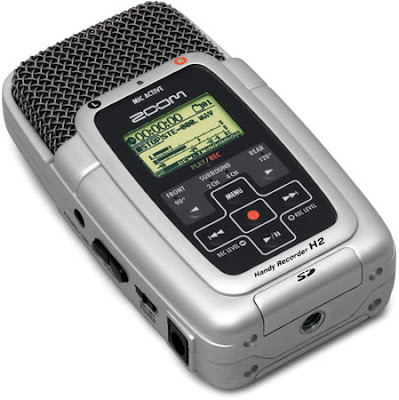
Consider this one of those "better late than never" type things. Zoom made a name for themselves in the early 2000's as a manufacturer of nicely made budget gear. Their early effects boxes weren't going to make Lexicon lose any sleep, but for dirt cheap, they opened up a nice range of effects in a single metal box to a whole array of bedroom musicians. The H2 (and the subsequent H4) Recorder has been out for some time now, and is something that has been on my wish list for a little while. On my last album, I got a bit back into sampling my own sounds from scratch again and started looking around for a decent, cheap solution for making field recordings. The H2 seemed like it had the right balance of features and reasonable price and looked to be a good starter level field recorder. So after getting back from my band's most recent tour last week, I decided to finally pick one up. What follows is less a proper review and more just some initial impressions. Make of them what you will, and if you're an H2 owner and disagree with something I've said here, by all means chime in.
If you've somehow missed it, the Zoom H2 is a portable audio recorder with an array of 2-4 built-in condenser mics (for stereo and surround recordings), that records to SD cards. What makes it most appealing is the price... generally between $140-$160 depending on where you shop. Mine was advertised as coming with only a 512MB card, but actually included a 1 GB card. Not sure of that is normal or if I just lucked out, but for my purposes - short recordings of real world sounds and not full length concert bootlegs - it's perfect.
My first impression upon opening the box was how cheap the Zoom H2 felt. It appears to be well-constructed enough, but is made out of the same super-light plastic some of the recent budget Korg effects have been. It may very well be durable, but it feels like it might just shatter to pieces if you gave it a good drop. So, that's definitely something to be wary of in a field recorder. That aside, my other first impression was that it was nice to see so many accessories included. You get a USB cable for connecting it to your computer, a wind screen, a very bare bones foot mount to act as a stand, some ear buds, a mic stand adaptor, a stereo Y-cable, and an AC adaptor. In an age where it is commonplace for companies to nickel and dime their customers to death by charging them piece by piece for accessories like these, it's nice to have them thrown in for free.
In addition to using the built-in mics in various patterns, the H2 also has an 1/8" stereo input for accepting line-level signals from devices like musical instruments, home stereos, etc. 3 different gain levels are available for recording signals of different strengths and there is even a compressor/limiter effect that can be called in for recording extremely high levels if necessary.
Most operations take place on an LCD screen about the size of a postage stamp. It's not always the most legible interface in the world, but because operations are relatively basic here, it doesn't take much getting used to. Options such as setting the bit depth and sample rates of your recordings (up to 24-bit/96k) are selected via the left and right arrow keys (rewind and fast-forward). This was a bit counter-intuitive when selecting items from bottom to top would've fit using the up and down keys a lot more logically, but aside from setting your input levels, you shouldn't have to venture into the menus too often anyway.
In addition to straight up field-recording duties, the H2 can also act as a USB mic for those of you looking to get into podcasting or screencasting, or as a tuner for bassists and guitarists. Very handy! Because of the USB, all of the recordings you make on your H2 can be directly transferred to your laptop where they can be easily edited and archived.
In practical use, I found the H2 to be pretty spectacular, especially considering the price. The mics, while no Neumann's by any stretch, sound very clear and detailed. Likewise, USB operation was simple and bug-free from my tests. I'll be using this on the screencast tutorials I hope to start adding to the site for sure. The only real issue, as I mentioned before, is the build quality. The lightness of the plastic body picked up rumble and 'body noise' like no one's business, so this is something you'll definitely want to mount on a stand or tripod of some sort versus just holding it in your hand. I have a little super-flexible 6" tripod set-up for my Flip video camera that does the trick very nicely.
Overall, I think this thing comes in on the right side of bang vs. buck by a pretty comfortable margin. I can't confirm that it's going to be perfect for every option out there, but for my initial round of sampling found objects, I was very impressed. I have yet to try any outdoors recordings, so I'll keep you posted on that, but in the meantime, I have absolutely no qualms recommending this to beginner field-recording enthusiasts such as myself. Dissenting thoughts from those of you with more experience with this than I are definitely welcome!

















































